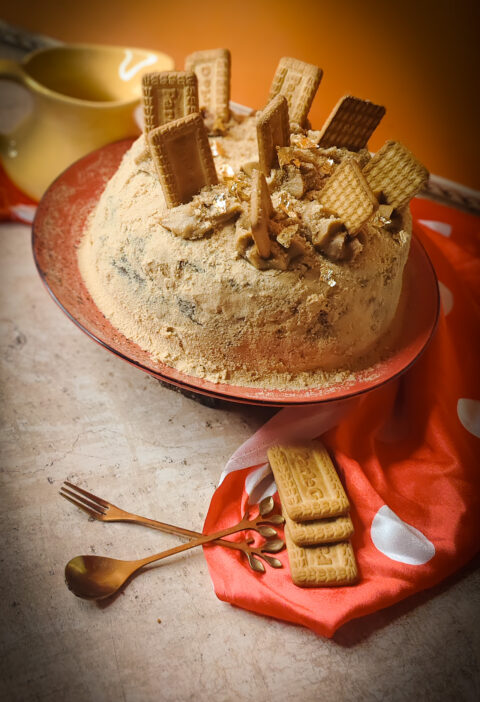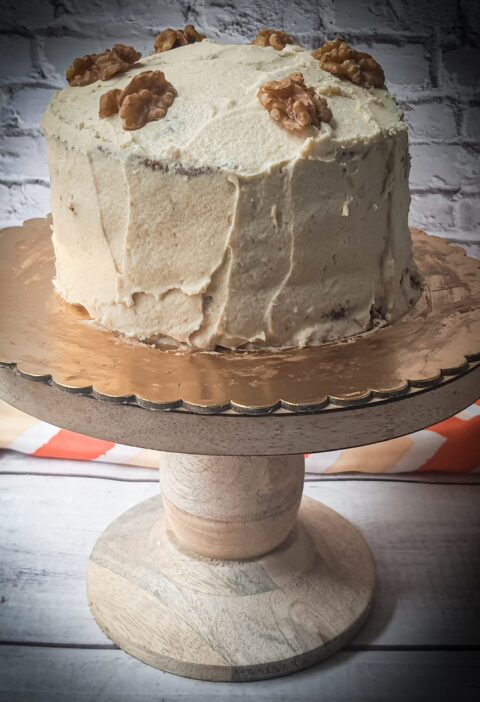
Most of my summer holidays as a child were spent at my granny’s house and she used to make this amazing honey apple upside-down cake. I remember the smell of the cake as it baked, the whole kitchen used to smell divine. I used to eat the cake as soon as it came out of the oven, hot cake with cold vanilla ice cream. the sticky gooey caramelized apples on top were delicious. I remember burning my tongue and eating this cake hot ignoring my granny’s warnings. It was so good that I could hardly wait.
Sadly, my granny passed away many years ago and the recipe for honey apple upside-down cake was lost to us. For many years, I tried to recreate the recipe, but it wasn’t the same until one day it happened and I cracked the recipe. It has taken a few tries to make it right. This recipe combines the natural sweetness of apples with the rich, golden flavor of honey. Whether you’re new to baking or a seasoned pro, you’ll appreciate the simplicity of this recipe. The ingredients are easy to find, and the steps are clear and manageable. With just a few simple techniques, you’ll create a beautiful cake perfect for any occasion. The caramelized apple slices on top add a touch of elegance, making this cake look as impressive as it tastes. The honey gives it a deep, natural sweetness that perfectly complements the tender apples and soft, moist cake. It’s mildly spiced, with a tender crumb.
What is a honey apple upside-down cake?
A Honey Apple Upside-Down Cake is a delightful dessert that features caramelized apple slices arranged on the bottom of the baking pan, with a rich honey-infused batter poured over them. Once baked, the cake is inverted (flipped upside down) onto a serving plate, showcasing the beautifully caramelized apples on top. This method creates a visually stunning cake with a deliciously sweet and fruity top layer.
Why is it Called an Upside-Down Cake?
The name “upside-down cake” comes from the unique baking technique used to create it. In a traditional cake, the batter is poured into the pan, and any toppings are added afterward or served separately. However, in an upside-down cake, the topping (usually a combination of fruit and a sugary glaze) is placed at the bottom of the pan before the batter is added. After baking, the cake is turned upside down, so the once-bottom layer of fruit becomes the top, creating a beautiful and flavorful presentation. This technique not only enhances the cake’s appearance but also infuses the fruit’s flavor and sweetness throughout the cake.
History of Upside-Down Cakes
The concept of upside-down cakes has a long and varied history, rooted in practicality and culinary tradition. Here’s a brief overview of how this beloved dessert evolved:
Early Origins
The practice of cooking cakes upside-down can be traced back to the Middle Ages when cooks would bake in cast-iron skillets over open flames. This method allowed them to easily combine and cook fruits with batter, creating a sweet, caramelized topping. The ease of flipping the cake out of the skillet made it a convenient dessert option.
Pineapple Upside-Down Cake
The upside-down cake gained significant popularity in the United States in the early 20th century, particularly with the advent of canned pineapple. The Dole Pineapple Company played a pivotal role in popularizing the pineapple upside-down cake. In 1925, they sponsored a recipe contest that received over 2,500 entries for a pineapple upside-down cake alone. The winning recipes were widely publicized, cementing the cake’s status as a classic American dessert.
Variations and Evolution
While the pineapple version is perhaps the most iconic, upside-down cakes can be made with a variety of fruits, including apples, pears, peaches, and cherries. The basic concept remains the same: a layer of fruit and sugar is placed in the bottom of the baking pan, and cake batter is poured over it. After baking, the cake is inverted, revealing the beautifully caramelized fruit topping.
Modern Interpretations
Today, upside-down cakes continue to be a popular choice for home bakers and professional chefs alike. The versatility of the recipe allows for endless creativity, with different fruits, flavorings, and even savory versions being explored. The honey apple upside-down cake, for example, combines the traditional technique with the natural sweetness of honey and the tartness of apples, offering a fresh twist on the classic.
In summary, the upside-down cake has a rich history that spans centuries and continents, evolving from a practical cooking method to a beloved dessert with endless variations. Its enduring appeal lies in its simplicity, visual appeal, and deliciously caramelized fruit topping.
Ingredients
Instructions
- Melt Butter 30 gm and pour it in a 9-inch round tin. Spread brown sugar over the melted butter.
- Arrange the apple slices on top of the sugar and place the cherries in the center of each apple ring. Set aside.
- Cream the 215 gm of butter and the honey together until nice and smooth. Add the egg and give it a good mix.
- Dissolve the soda into the buttermilk. Keep aside.
- Now combine/ sift flour, baking powder, pumpkin spice and add to the creamed mixture alternatively with the buttermilk mixture. Beginning and ending with flour. Beat well and spoon the batter evenly over the apple rings.
- Bake at 180 degrees C for 40 minutes or until the skewer comes out clean. Cool for 5 minutes and invert the cake onto a serving plate. Serve warm with whipped cream or ice cream. Enjoy!
Please try this recipe and leave a comment below if you are happy with it. Some more recipes that you can try are
Eggless Mango Cake with White Chocolate Ermine Frosting.
Do try these recipes and let me know how it went. I look forward to hearing from you. Join my growing Instagram and Facebook pages.
Love
N







